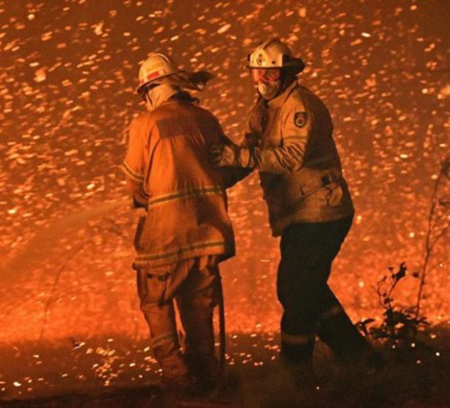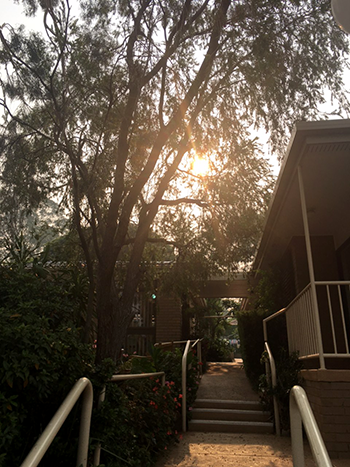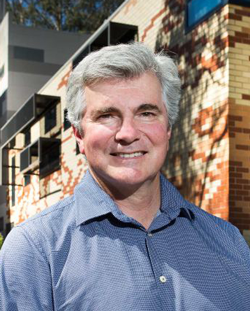VIEW AND DOWNLOAD WORLD TENNIS GAZETTE VOL. 12 NO. 6
By JOHN MARTIN

Agence France Presse
MELBOURNE, Australia — The 2020 Australian Open begins here tomorrow (Jan 20) amid a struggle to safely conduct one of the world’s most prestigious tennis championships threatened by smoke from fires hundreds of miles away.
In the final days before play began, tournament officials and health specialists crafted a five-category set of rules to govern the decisions to suspend or resume play.
Key factors include the amount of particles detected by monitors throughout the grounds and courts at Melbourne Park.
Concerns about safety have been growing for months as bushfires spread. But late in December, The Washington Post reported that climate change was taking a dramatic turn in Australia:
“Nearly 100 fires are burning in New South Wales, nearly half of them out of control. Residents of the state, where Sydney sits, wear breathing masks to tolerate the heavy smoke, which has drifted more than 500 miles south to the outskirts of Melbourne.”
With less than a month to prepare before the first qualifying matches at Melbourne Park, the news could not have been more discomforting for the world’s top professional tennis players.
After a practice session before qualifying rounds began, American Denis Kudla told Ben Rothenberg of The New York Times he could not inhale or exhale fully without coughing while on court. If the smoke persisted at the same level, Kudla said, “You could play, but who knows what damage we’re actually causing ourselves? It can’t be good.”
One scholar who should know the danger is Damian Farrow, a sports science professor at Melbourne’s Victoria University.

In a 2013 essay, he described oxygen as a kind of elixir, replenishing the strength of an athlete.
“The gold standard technique of assessing a person’s aerobic fitness is to
measure their maximal oxygen uptake,” Farrow wrote, long before the country’s forests began erupting in flames.
Oxygen uptake, he said, “measures the respiratory and cardiovascular systems (lungs and heart) and their ability to deliver oxygen to the working muscles.”
There is another measurement players watch, he wrote: “…the capacity of muscles to utilize that oxygen to produce energy.” Farrow, a former tennis coach, declined to discuss the current air quality situation, citing university duties.
Players struggled through the first two days of qualifying, citing breathing problems that led officials to delay and then suspend matches. A freakish rainstorm added to delays and confusion.
Eugenie Bouchard, the 2014 Wimbledon finalist, said she suffered chest pains, feeling “spikes in her lungs,” according to The New York Times. One player compensated for breathing problems by hitting her serves underhanded, The Times reported..
Liam Broady of Britain complained to the Daily Mail: “We are all human beings. This is pretty bad for you to be running around in these conditions.”
Questions swirled.
How does smoke affect energy? How can players gauge the capacity of their muscles to produce energy?

World Tennis Gazette/John Martin
A few days into January, the ATP Player Council signaled it wanted to discuss the safety implications for the championship.
The tournament quickly pledged to move play if necessary into the filtered air of three domed stadiums and eight indoor practice courts at Melbourne Park.
Meanwhile, Tennis Australia embarked on a series of fundraising efforts to assist victims of the fires. One method was to donate funds for each ace hit in tournament matches. A nighttime appearance at Rod Laver Arena by nearly a dozen top players raised more funds, including half a million Australian dollars in two equal checks from Roger Federer and Rafael Nadal.
Total donations from throughout what was described as the “tennis world” amounted to more than $4,800,000 (Australian dollars), according to Tennis Australia.
The storms affected smaller tournaments as well as large. The Canberra International was shifted with only three days’ notice to Bendigo, nearly 290 miles away, because of forecasts of heavy smoke conditions.
“The health of players, fans, volunteers, staff and stakeholders is our biggest priority at all times,” a tournament executive said.
Tennis Australia CEO Craig Tiley said safe conditions were a prime objective for all and pledged to raise funds for fire victims throughout the continent. But he took note of the particular predicament facing hundreds of players, many of whom had traveled from distant countries to compete.
“We know how important the tournament is for players preparing to play at the Australian Open and the decision to move the tournament from Canberra to Bendigo has been made to ensure they can still compete,” Tiley said.
“We will continue to monitor the situation across the country and ensure we have the most accurate information to make any decisions about play.”
At mid-month, bad air quality forced suspension of tournament play even in Bendigo.
At the same time, a NASA satellite map published by The Washington Post indicated the fires have “affected the heart of the forest ecosystems” on the southeastern coast.
“These forests help support water supplies for the most populated regions of the country, such as Sydney and Melbourne.”
Mark Howden, director of the Climate Change Institute at the Australian National University, said the bush fires appeared to be “a less than a one-in-a-hundred year event.”

“What appears to be different in this fire season,” Howden told the South China Morning Post, “is the sheer spatial extent of the fires – a combination of ferocious and very extensive.”
“We know that fire risk is driven by four main factors: drought conditions which result in very dry fuel – leaves, grass, branches etc – high temperatures, high winds and dry air,” Howden said.
“There is increasing evidence that climate change is driving more drought conditions, particularly in the mid-latitudes where Australia sits. There is extremely strong evidence that temperature increases are being driven by human emissions of greenhouse gases.”
The Morning Post, based in Hong Kong, quoted the 2020 Climate Change Performance Index, released last month, which ranked Australia 57th among 57 countries assessed for climate policy effort and effectiveness.
Australian Prime Minister Scott Morrison has resisted calls for stronger efforts to reduce greenhouse gas emissions, according to The Washington Post.
For the world of tennis, the challenge is especially steep. Tournament referees and chair umpires across the globe must master a new set of rules by which they conduct matches threatened by smoke.
The 2020 Australian Open Air Quality Ratings create five categories. The first identifies “good playing conditions” as air that contains less than 27 particles per sample.
A particle is defined as an object that is 2.5 micrometers or less in diameter.
The policy cites 27 to 62 particles as “moderate playing conditions.” It calls for the tournament referee to consider suspending a match when the particle count rises between 97 and 200.
The referee must suspend any match when the count rises above 200 particles.
Interestingly, the match doesn’t stop automatically when the particle count reaches an undesirable level. Play continues “until the completion of an even number of games in that set (or completion of a tiebreak if applicable).”
Referees assume a crucial role, the policy paper explains:
“At any point the Referee may decide to suspend, maintain or resume match play at his or her absolute discretion…taking into account advice from onsite medical experts, visibility, forecast changes to weather conditions and any other factors deemed relevant” to assessing air quality.
As opening day approached, reporters asked Rafael Nadal his opinion of the policy. Was it strong enough to protect players?
Nadal’s face, often a clue to his thoughts, assumed a slight frown, then softened with a modest smile.
He said he had been told that the International Olympic air quality code, which protects the world’s top athletes, suspends play when the number of particles reaches 300 per million. When he asked about the Open’s policy and was told it was stricter by allowing 100 fewer particles, “I received an answer that convinced me.”
Both Nadal and Roger Federer said they endorsed the AO policy.